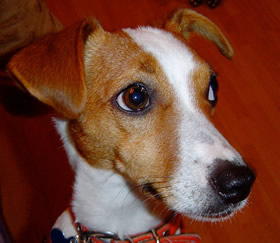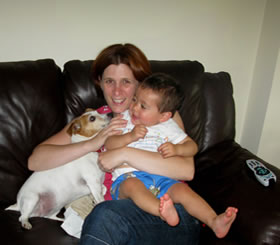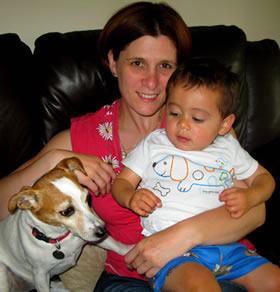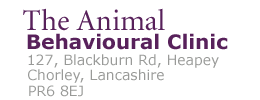|
 Jane’s story of rescue dog ‘Lucy’ Jane’s story of rescue dog ‘Lucy’
I never thought I would see the day when Lucy, my Jack Russell, would be sat in close proximity to a child, let alone sat right next to a child. Lucy is a rescue dog and we acquired her in 2003 at the age of 7 months. A very lively Jack Russell, but she was rather cute. Little did I know what I was letting myself in for! I only wanted a small dog but it seems that some smaller dogs can have very big attitudes!
‘Something in the way she moves’
Lucy was and still is a very loving dog, but her antisocial behaviours soon began to let her down and generally, she became a real problem for me. Basically, Lucy didn’t like anything that moved that wasn’t under her control; dogs, cats and children and in addition she was proving to be extremely hyperactive. Her behavioural problems were evident right from the very beginning. She attacked cats, barked aggressively at dogs, jumped all over our guests and squealed loudly at children. I tried to control her as much as I could, but the final straw came on day when Lucy jumped up and nipped a child whilst we were out on a walk. Thankfully, the child wasn’t seriously injured and the family didn’t take the incident any further. I knew at that stage that I had to take action. I knew that I wanted children of my own eventually and I didn’t know what to do. I loved Lucy to bits and I didn’t want to part with her. People were telling me to rehome her; but I couldn’t do it and I didn’t want to. By doing this I would simply be passing on Lucy and her problems to somebody else and they may not have been as patient as me.
‘Help, I need somebody!’
I trawled the internet for help and thankfully I came across Dr David who came to the rescue with his step by step Behaviour-modification Program.
For anybody with a problem dog who is looking for a quick fix, think again. It doesn’t work like that. It takes a lot of hard work, time and willpower to see it though, but it is worth it.
Dr David Sands
I arranged a home visit on the 20th October 2006 with a preliminary diagnosis of a dog with behavioural conditions including ‘canine-insecurity’, ‘fear-based aggression’ (target associated), challenging-behaviour (status-associated) and Separation-related Disorder (owner hyper-attachment). The Program meant that Jane had to teach Lucy a new communication system, new interactive rules and give her new boundaries in the home.
 ‘It’s getting better’ ‘It’s getting better’
I found the program really hard, but I knew I was doing it for a reason. Lucy’s behaviour improved dramatically and I couldn’t believe the difference in her, however, I still didn’t have the confidence to mix Lucy with children. This was still an issue for me. Not 6 months later I discovered I was pregnant and the idea that Lucy could be dangerous with children was causing me an awful lot of distress. I found myself thinking about the fact that Lucy may not mix well with my baby. Again, Dr David stepped in and gave us some valuable advice. He came to the house again and actually allowed Lucy to mix with children right in front of my very eyes and she didn’t bite them. I knew it was possible and that gave me fresh hope.
Dr David Sands
I arranged a home visit on the 17th November 2007. The idea was to bring Max, my young son, who was confident with dogs to show Jane how any potential problem behaviour from Lucy could be countered in the right way. It was important that a positive association was made with a young person. The unknown past of a rescue dog means that in the early stages of Lucy’s life she may have had a negative association with a child. It was also possible that the erratic movements of some children could be triggering a nervous response from Lucy.
This second home session, focusing just on child-associated responses, went extremely well and probably gave Jane the confident to move on in a positive way with Lucy.
‘Lucy in the sky’
When my husband and I brought the baby home for the first time, Lucy didn’t react well at all. She was wound up, hyperactive, her adrenalin was pumping, she couldn’t keep still and was constantly trying to get at the baby. It is stressful enough bringing a baby home, but having a dog to contend with as well is more than enough. I nearly gave up several times and shipped her off to my parents, but I had to persevere. Sending her to my parents wasn’t solving anything.
 ‘It’s getting better all the time’ ‘It’s getting better all the time’
A week after my new son came home, Lucy hadn’t changed at all and I didn’t think it was going to work. One phone call to Dr David, some more advice and reassurance that we would see a change shortly, encouraged us to carry on and it wasn’t long before we started to see a change and Lucy began to ignore the baby for longer and longer. I was so relieved. I always made sure that there was a distance between Lucy and my son and that she never jumped up because I still wasn’t sure what she would do, but she started to calm down and relax more and more. The more she proved herself, the more confidence I had in her and the more freedom I allowed her to have. When my son started to move around, there lay a new hurdle. Lucy didn’t like it at all, so it was back to basics and this worked.
‘All you need is love’
Nearly 2 years on and I can’t believe the difference. Joseph, my son, knows to treat Lucy with respect and vice versa. I let Joseph stroke Lucy, but this is done under supervision and he knows to be gentle with her. There have been the odd mishaps where Joseph has stood on her by accident or grabbed her tail, but thankfully Lucy took it rather well and although she yelped, she didn’t bite. I can’t tell you how happy I am and I can’t thank Dr David enough.
Dr David Sands
Some final words. Jane’s story with Lucy is heart warming. I do believe family comes first (as a family man). I only had confidence to help Jane with Lucy because I could see a dog that just needed clear signals and some structure and boundaries in the home like a hyperactive child (but without even the brain of a child).
We are the ‘voice’ for our companion animals. It would be easier to re-home or euthanise a dog that has psychological issues than to undergo a long rehabilitation program. However, consider if every human with a psychological problem was to be re-homed or ‘put to sleep’. How many people would be missing (including me)!
It is advisable never to leave a dog unsupervised with a young baby even if the dog has been in the home from the earliest puppy stage. This is especially vital when a baby starts to become mobile in the home because hyperactive dogs are stimulated by movement and yet crawling is an important progress in infant development. A rescue dog has an ‘unknown past’ and so cannot ever be completely trusted. However, with professional guidance and long term rehabilitation, a calmer dog can learn to become a significant part of a young family. But remember, Baby must always come first!
Thanks to Jane and family for a lovely true story
7th October 2009
|







